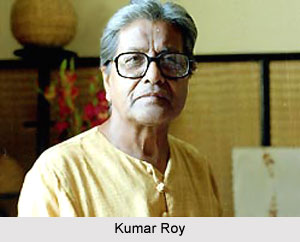 Kumar Roy was a Bengali actor-director, who was a renowned face in the Bengali theatre circuit, and headed the Paschim Banga Natya Academy for qite some time. He took charge of Bohurupee after Sombhu Mitra and Tripti Mitra withdrew. He was born in Dinajpur, East Bengal in 1926.
Kumar Roy was a Bengali actor-director, who was a renowned face in the Bengali theatre circuit, and headed the Paschim Banga Natya Academy for qite some time. He took charge of Bohurupee after Sombhu Mitra and Tripti Mitra withdrew. He was born in Dinajpur, East Bengal in 1926.
Early Life of Kumar Roy
He first made his mark as an actor for Bohurupee and continued to be the best in the troupe next to the Mitras. Memorable performances include Dr Roy in Putul khela i.e. Ibsen`s `A Doll`s House` in 1958, the king Gobindamanikya in Tagore`s Bisarjan or `Immersion` in 1961, the old Thakurda in Tagore`s Raja in 1964, Saradindu in Badal Sircar`s Baki itihas or `Remaining History` in 1967, and Shashi in Sircar`s Paglaghora or `Mad Horse` in 1971. To these were added the lead roles in Brecht`s Galileo in 1980 and Manoj Mitra`s Rajdarshan or `An Encounter with Royalty` in 1982, which he directed.
Life in Theatre for Kumar Roy
After the Mitra`s departure, Roy directed most Bohurupee productions, bearing its stamp of overall competence and finish. His first three attempts succeeded consecutively. The names can be mentioned as Sudraka`s Mrichchhakatika i.e. `The Little Clay Cart` in 1979. This was followed by Galileo and Rajdarshan. Similar achievement marked varied ventures like Mister Kakatuya or "Mr Cockatoo". This was adapted from Mary Chase`s Harvey in 1987, Manoj Mitras Kinu Kaharer theater i.e. `Klnu Kahar`s Theatre` in 1988, Bijon Bhattacharya`s Nabanna i.e. "New Harvest" in 1989, and Chittaranjan Ghosh`s Piriti param nidhi i.e. "Love Is the Supreme Asset" in 1994. He faithfully followed Bohurupee`s ideological commitment to Rabindranath Tagore, staging Malini in 1986 and reviving Muktadhara in 1996. Kumar Roy also discovered new dramatists like Sisir Kumar Das.
Kumar Roy taught at the Department of Drama at` Rabindra Bharati University, Kolkata. He also acted in films such as Satyajit Ray`s Teen Kanya i.e. `Three Daughters` in 1961 and Tapan Sinha`s Sagina Mahato in 1970. Roy designed sets and costumes, and wrote two popular plays, Ujan beye i.e. `Moving Upstream` in 1952 and Kimbadanti i.e. `Rumour` in 1970. The latter produced for Bohurupee by Tripti Mitra. In addition, he published books on Bengali theatre, most of which deal with Rabindranath Tagore and Sombhu Mitra.
Kumar Roy, winner of Sangeet Natak Akademi award in 1983, died on 27th February 2010 due to protracted heart ailment.




















